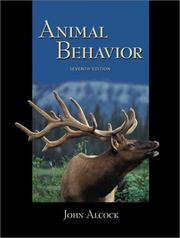| Listing 1 - 4 of 4 |
Sort by
|

ISBN: 0123504430 9780123504432 Year: 2001 Publisher: [Place of publication not identified] Academic Press Imprint
Abstract | Keywords | Export | Availability | Bookmark
 Loading...
Loading...Choose an application
- Reference Manager
- EndNote
- RefWorks (Direct export to RefWorks)
597.587.2 --- 591.1 --- 591.5 --- 591.5 Animal habits. Animal behaviour. Ecology. Ethology. Animal and environment. Bionomy --- Animal habits. Animal behaviour. Ecology. Ethology. Animal and environment. Bionomy --- 591.1 Animal physiology --- Animal physiology --- 597.587.2 Scombridae. Mackerel. Tuna (tunny) --- Scombridae. Mackerel. Tuna (tunny) --- Tuna. --- Thunnidae --- Thunnus --- Tuna fish --- Tunafish --- Tunas --- Scombridae

ISBN: 0878930116 Year: 2001 Publisher: Sunderland, Mass. : Sinauer Publishers,
Abstract | Keywords | Export | Availability | Bookmark
 Loading...
Loading...Choose an application
- Reference Manager
- EndNote
- RefWorks (Direct export to RefWorks)
Evolution. Phylogeny --- Animal ethology and ecology. Sociobiology --- Animal behavior --- Evolution. --- 591.5 --- 575.854 --- -Animals --- Animals, Habits and behavior of --- Behavior, Animal --- Ethology --- Animal psychology --- Zoology --- Ethologists --- Psychology, Comparative --- Animal habits. Animal behaviour. Ecology. Ethology. Animal and environment. Bionomy --- Tissue, organs and function --- Evolution --- Behavior --- -Animal habits. Animal behaviour. Ecology. Ethology. Animal and environment. Bionomy --- 575.854 Tissue, organs and function --- 591.5 Animal habits. Animal behaviour. Ecology. Ethology. Animal and environment. Bionomy --- -575.854 Tissue, organs and function --- Animals --- Behavior evolution

ISBN: 0716751690 9780716751694 0716751038 1572599332 Year: 2001 Publisher: New York Worth
Abstract | Keywords | Export | Availability | Bookmark
 Loading...
Loading...Choose an application
- Reference Manager
- EndNote
- RefWorks (Direct export to RefWorks)
612.82 --- 159.91 --- Nerve centres in general. Brain (cerebrum, encephalon) --- Psychofysiologie. Neuropsychologie. Psychomotoriek. Psychomotorische therapie --- 159.91 Psychofysiologie. Neuropsychologie. Psychomotoriek. Psychomotorische therapie --- 612.82 Nerve centres in general. Brain (cerebrum, encephalon) --- brains --- Nervous System Physiology --- 591.481.1 --- 591.18 --- Brain of vertebrates. Encephalon. Cerebellum --- Functions of the nervous system --- 591.18 Functions of the nervous system --- 591.481.1 Brain of vertebrates. Encephalon. Cerebellum --- 591.5 --- 591.5 Animal habits. Animal behaviour. Ecology. Ethology. Animal and environment. Bionomy --- Animal habits. Animal behaviour. Ecology. Ethology. Animal and environment. Bionomy --- Neuropathology --- Biology --- Animal physiology. Animal biophysics --- Human medicine --- Psychology --- Brain --- Human behavior --- Neurophysiology --- Nervous system --- Neurobiology --- Physiology --- Action, Human --- Behavior, Human --- Ethology --- Human action --- Human beings --- Human biology --- Physical anthropology --- Social sciences --- Psychology, Comparative --- Cerebrum --- Mind --- Central nervous system --- Head --- Physiological aspects --- Behavior --- Nervous System Physiological Phenomena --- Neuropsychology --- physiology --- Brain - textbooks --- Brain - Textbooks --- Behavior - Textbooks --- Human behavior - Textbooks --- Human behavior - Physiological aspects - Textbooks --- Neurophysiology - Textbooks --- Nervous System Physiology - Textbooks --- Behavior - physiology


ISBN: 9780691116242 0691116245 0691012113 9780691012117 Year: 2001 Publisher: Princeton : Princeton University Press,
Abstract | Keywords | Export | Availability | Bookmark
 Loading...
Loading...Choose an application
- Reference Manager
- EndNote
- RefWorks (Direct export to RefWorks)
The synchronized flashing of fireflies at night. The spiraling patterns of an aggregating slime mold. The anastomosing network of army-ant trails. The coordinated movements of a school of fish. Researchers are finding in such patterns--phenomena that have fascinated naturalists for centuries--a fertile new approach to understanding biological systems: the study of self-organization. This book, a primer on self-organization in biological systems for students and other enthusiasts, introduces readers to the basic concepts and tools for studying self-organization and then examines numerous examples of self-organization in the natural world. Self-organization refers to diverse pattern formation processes in the physical and biological world, from sand grains assembling into rippled dunes to cells combining to create highly structured tissues to individual insects working to create sophisticated societies. What these diverse systems hold in common is the proximate means by which they acquire order and structure. In self-organizing systems, pattern at the global level emerges solely from interactions among lower-level components. Remarkably, even very complex structures result from the iteration of surprisingly simple behaviors performed by individuals relying on only local information. This striking conclusion suggests important lines of inquiry: To what degree is environmental rather than individual complexity responsible for group complexity? To what extent have widely differing organisms adopted similar, convergent strategies of pattern formation? How, specifically, has natural selection determined the rules governing interactions within biological systems? Broad in scope, thorough yet accessible, this book is a self-contained introduction to self-organization and complexity in biology--a field of study at the forefront of life sciences research.
Biological systems --- Self-organizing systems --- Systèmes auto-organisés --- Biological systems. --- Self-organizing systems. --- Systèmes biologiques --- Biological Science Disciplines --- Systems Theory --- 591.5 --- 591.5 Animal habits. Animal behaviour. Ecology. Ethology. Animal and environment. Bionomy --- Animal habits. Animal behaviour. Ecology. Ethology. Animal and environment. Bionomy --- General Systems Theory --- Queuing Theory --- General Systems Theories --- Queuing Theories --- Systems Theories --- Systems Theories, General --- Systems Theory, General --- Theories, General Systems --- Theories, Queuing --- Theories, Systems --- Theory, General Systems --- Theory, Queuing --- Theory, Systems --- Systems Biology --- Biologic Sciences --- Biological Science --- Science, Biological --- Sciences, Biological --- Biological Sciences --- Life Sciences --- Biologic Science --- Biological Science Discipline --- Discipline, Biological Science --- Disciplines, Biological Science --- Life Science --- Science Discipline, Biological --- Science Disciplines, Biological --- Science, Biologic --- Science, Life --- Sciences, Biologic --- Sciences, Life --- Learning systems (Automatic control) --- Self-optimizing systems --- Cybernetics --- Intellect --- Learning ability --- Synergetics --- Biosystems --- Systems, Biological --- Biology --- System theory --- Systems biology --- Philosophy --- BIOLOGICAL SYSTEMS --- SELF-ORGANIZING SYSTEMS
| Listing 1 - 4 of 4 |
Sort by
|

 Search
Search Feedback
Feedback About
About Help
Help News
News